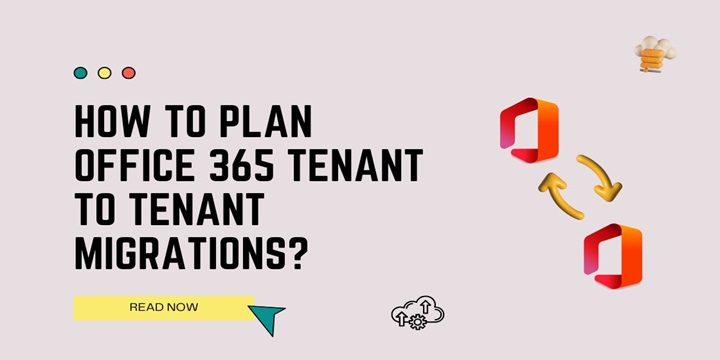Office 365 tenant to tenant migration is a critical process for businesses undergoing mergers, acquisitions, divestitures, or restructuring. Proper planning ensures a smooth migration with minimal disruption, preserving business continuity and data integrity. This article will guide you through the essential steps to effectively plan an Office 365 tenant to tenant migration and discuss key considerations, including Manual O365 Mailbox Migration.
Understanding Office 365 Tenant to Tenant Migration
An Office 365 tenant to tenant migration involves moving data, such as emails, mailboxes, SharePoint sites, OneDrive accounts, and Teams, from one Office 365 tenant to another. This process can be complex, requiring careful preparation to ensure no data loss, security breaches, or disruptions during the migration.
Organizations often need tenant migrations for reasons such as:
- Mergers and Acquisitions: Consolidating separate Office 365 tenants into one.
- Divestitures: Splitting a tenant into multiple tenants.
- Rebranding or Restructuring: Moving workloads under a new tenant.
The planning phase is critical as it sets the foundation for a successful migration.
Key Considerations Before Starting the Migration
Before you begin the migration, it is important to evaluate several factors:
- Scope of Migration: Identify which data needs to be moved (e.g., mailboxes, SharePoint sites, Teams).
- Timeline: Define a migration timeline to align with business priorities and minimize disruptions.
- Resources: Assess internal expertise and whether external tools or services are required.
- Licensing and Permissions: Ensure the target tenant has proper licenses and the permissions.
- Data Volume and Size: Estimate the data size for mailboxes, files, and sites to anticipate migration time.
Pre-Migration Planning
Proper planning is the backbone of a successful migration. Below are the critical steps you need to take during the pre-migration phase:
Assessment and Discovery
- Perform a detailed analysis of both the source and target Office 365 tenants.
- Identify all the mailboxes, OneDrive accounts, SharePoint data, Teams channels, and other data that require migration.
- Note down data volume.
Prepare the Target Tenant
- Set up the target tenant, ensuring it has sufficient licenses, resources, and configurations.
- Configure DNS records, domains, and email routing in advance.
- Verify that user accounts and groups are created and synchronized in the target tenant.
Communication Plan
- Inform all stakeholders, including employees, IT teams, and management, about the migration.
- Clearly outline the migration timeline, potential downtime, and user responsibilities.
- Provide training materials and resources for end-users to mitigate confusion post-migration.
Choose a Migration Method
You can choose between manual O365 mailbox migration or automated tools depending on the scope and complexity of the project.
Manual O365 Mailbox Migration
Manual migration is an option for small to medium-sized organizations with fewer mailboxes to move. However, it requires careful execution and thorough understanding of Exchange Online and PowerShell.
Steps for Manual O365 Mailbox Migration:
- Prepare Source and Target Tenants
- Verify DNS and domain configurations in both tenants.
- Set up the necessary permissions to access mailboxes and manage migrations.
- Use Migration Tab and PowerShell for Migration
- Use PowerShell scripts to fulfill the requirements of migration.
- Execute the migration through Exchange Admin Center.
As manual method is very lengthy and requires proper planning. You can check out this guide on Manual O365 mailbox migration to learn about the complete process in detail.
- Validate Data Transfer
- Verify that all mailboxes have been successfully migrated with complete data.
- Test accessibility and data integrity for mailboxes.
- Reassign Permissions and Redirect Users
- Update permissions for shared mailboxes, calendars, and groups in the target tenant.
- Communicate the change to end-users and guide them on accessing their new mailboxes.
- Post-Migration Steps
After the migration is complete, perform the following tasks to ensure everything works as expected:
- User Validation: Confirm that users can access their mailboxes, files, and tools.
- Update DNS Records: Ensure DNS settings are correctly pointing to the target tenant.
- Deactivate Source Tenant: Once data is validated and no longer needed, decommission the old tenant.
- User Training: Provide support and training materials to help users adapt to the new environment.
Best Practices for Office 365 Tenant to Tenant Migration
- Plan Ahead: Plan before the migration for smooth move.
- Perform Backups: Always back up critical data before starting the migration.
- Test Thoroughly: Conduct small migrations to check and resolve issues early.
- Communicate Clearly: Keep everyone informed throughout the process.
- Minimize Downtime: Perform migrations during off-peak hours to reduce business disruption.
Limitations of Manual Migration:
- Time-consuming for larger organizations with significant data.
- Requires technical expertise in PowerShell and Exchange Online.
- Risk of data loss or corruption if not executed properly.
Conclusion
Office 365 tenant to tenant migration process requires you to plan, prepare and execute properly to avoid any issues. While manual O365 mailbox migration is a good option for smaller organizations, it requires technical expertise and time investment. For larger migrations, automated tools may be a more efficient solution.
Read More: Epic CVX Technologies
